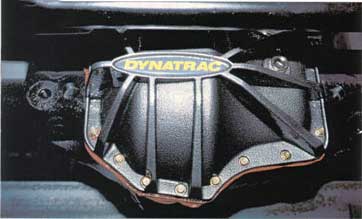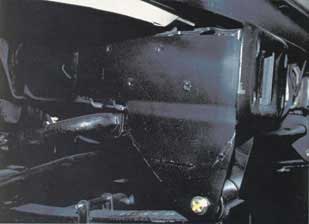
Sportsmobile has been building van campers for more than 40 years.
Back in the 60s they applied their experience with VWs to the Ford E-350 van, and later, using the Quigley 4WD conversion and the Power Stroke Diesel, they created what surely must be one of the most practical, best designed backroad and off-road travel and camping vehicles on the market. While the Quigley system has worked well, with the introduction of the 2003 and 2004 models of the E-350 and 7.3L and 6.0L Power Strokes, Sportsmobile West has taken the steps to design and assemble their own four-wheel drive conversion.
Heading up the project was Fred Whorff. Besides being a competent engineer and an avid four wheeler, Fred has a unique eye for detail. The all new Sportsmobile Power Stroke 4WD E-350 van is for the most discerning off-road/backroad enthusiast. Only the highest quality components were used.
Fred has seen the shortcomings of other conversions and corrected them in the process. Looking at his work, you get thefeeling that Alan Feld, President of Sportsmobile West, pretty much gave him a blank check. Do it right the first time.
Starting with a basic Ford E-350 van with a Power Stroke 6.0 L ( a 7.8 L V-10 is available for those who don’t know better), most of the drive train, except for the engine and transmission, is removed. At the rear, the Dana 60 semi-floating axle is retained, though there is an option for a Dynatrac full-floating replacement. Up front, a Dynatrac Pro-Roc 60 axle is installed. The Pro-Roc features a high knuckle front design to maximize clearance. Turning radius has been reduced to 39 ft., 2 in. That’s nearly 3 ft. tighter than a stock two-wheel drive Ford van. Both front and rear axles can be equipped with limited slip or locking differentials from Eaton, ARB, or Tractech. The standard axle gear ratio is 4:10:1.
Custom springs are installed all around. A reverse shackle design is used in the front for a better ride, and all spring packs have a partial military wrap designed specifically for the Sportsmobile. Old Man Emu has developed custom valved shocks for the new conversion. Some earlier models used the Rancho 9000 adjustable.
All steering linkage is mounted as high as possible. By keeping the drag link virtually horizontal, bump steer is practically eliminated. The custom heat-treated front 1.38-inch sway bar has a unique quick-disconnect which will increase the Sportsmobile’s wheel travel to 12 inches for serious off-highway conditions.
Behind the TorqShift 5-speed, a shorter output shaft feeds power to an Advanced Adapters Atlas II all-gear-driven transfer case with a 3.0 or 3.8:1 gear ratio. The drive train has been beefed up with Spicer 1350 one-ton components on the front and Spicer 1410 Series on the rear. Looking up at the new system on the rack, well designed skid plates and reinforced frame sections where most stress is transferred showed impressive attention to detail.
The overall length of the regular wheel-base is 211.9”; departure angle is 32 degrees; and approach angle is 44 degrees. By installing the Sportsmobile Track Right wheel spacers on the rear hubs, the front and rear wheels track identically at 70.5 inches.
Equipment options include a rear sway bar, Alcoa one-piece hot forged aluminum wheels with BFG Goodrich All Terrain or Mud Terrain tires, Bushwacker fender flares, an on-board air compressor, custom bumpers and grill guards with a winch and auxiliary lights, just to name a few.
Once the base vehicle is finished, the interior living options are nearly endless. The Penthouse pop-up roof is the secret to low center of gravity and highway handling, yet the self-contained camper typically can sleep four and has a stove, microwave, refrigerator, toilet, and hot and cold water.

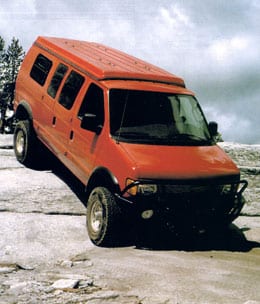
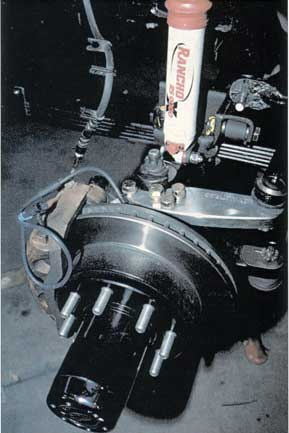
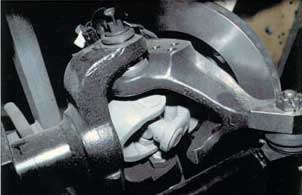
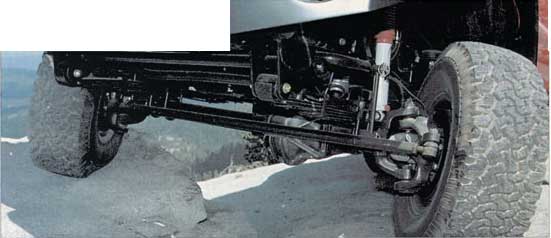
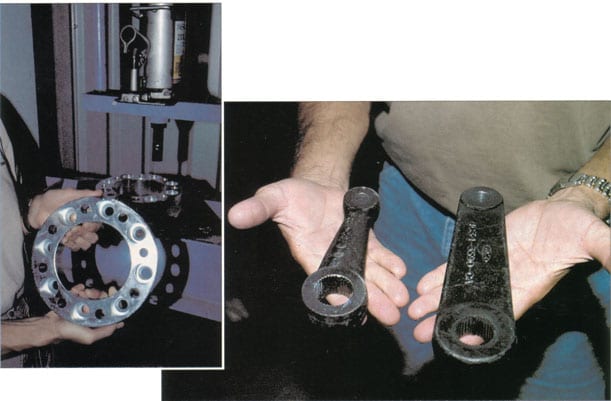
Right: The factory Ford E-350 pitman arm (left) is replaced with a much stronger model used on the F-450 Ford Super Duty.
For a test drive, we met Fred and John Kalmach at the Sportsmobile factory one crisp morning and motored up into the Sierras behind Fresno. Turning off the blacktop and locking the hubs, we headed up the Bald Mountain trail to a fire lookout tower. Sierra silt billowed behind us as we crawled over broken slabs of granite so steep and slippery, they were a challenge to walk. Fred had pulled the pins on the quick-disconnect sway bars to increase our wheel travel. On occasion, we locked in the ARB differentials, but nothing seemed to slow our progress. The Sportsmobile never spun a tire.
Reaching the top, we were just admiring the view when a group of fat-tired Jeeps rumbled up the rocky incline. We chatted with them about the usual stuff, but you could sense that they were somewhat amazed to see that a fully self-contained van had made the difficult climb look like a drive in the country. Half way down the backside, we stopped to have lunch. Hot coffee was brewed in the van’s kitchen, and hotdogs were heated in the microwave. With a little more time, we could have camped here overnight — or for a week!
We have always thought of backroad travel as a game. The game is, “How far off the beaten track can you go and still be comfortable when you pull the key out?” The new Sportsmobile 4WD conversion has made that game a lot more fun! The Turtle Expedition is currently working with Sportsmobile and a French gentleman to design a 4×4 van specifically for travel in Mexico, Central and Southern America. We’ll have a report on that project in a future issue.
Sportsmobile 4WD
